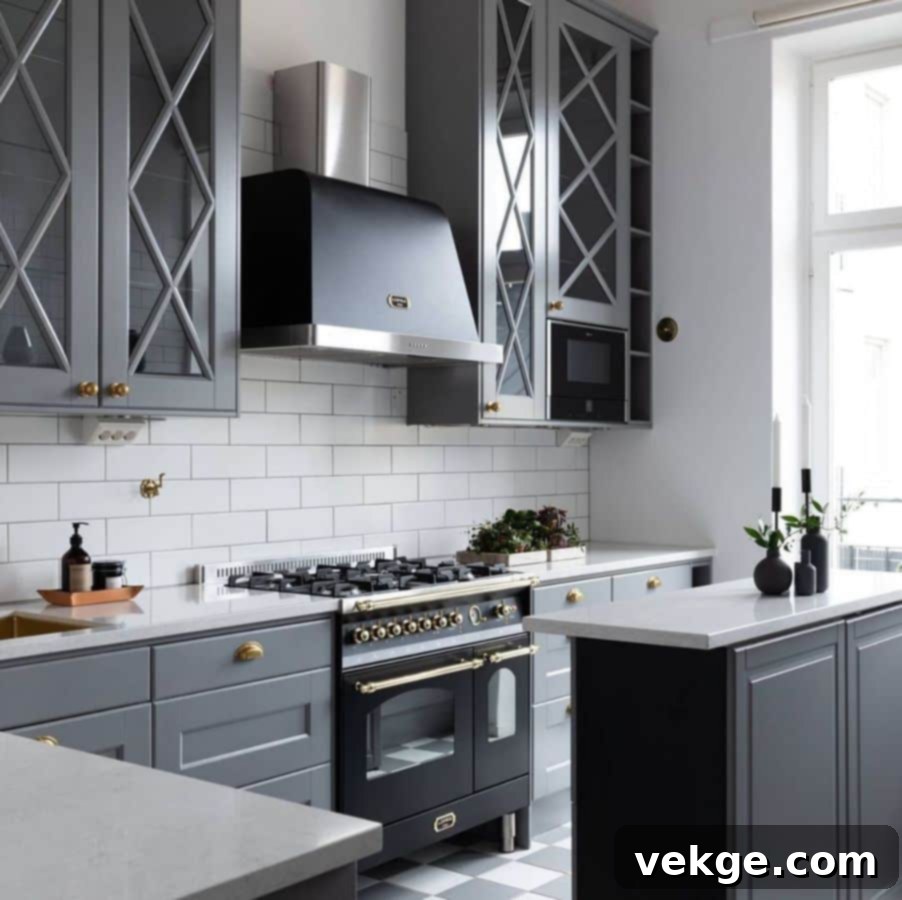Transform Your Home: 15 Modern Scandinavian Kitchen Design Ideas for a Stylish & Functional Space
The kitchen isn’t just a place to prepare meals; it’s often the vibrant heart of the home – a gathering space for cooking, eating, entertaining, and making memories. It’s also a prime area to express your personal style and design preferences. If you’re seeking inspiration to elevate your kitchen’s aesthetic and functionality, you’ve landed in the perfect spot!
Scandinavian kitchen design, a style renowned globally for its clean aesthetics and practical approach, originated in Sweden before gracefully spreading across the Nordic region to Denmark, Finland, and Norway. This design philosophy champions minimalism, simplicity, and unwavering functionality, aiming to create spaces that are both beautiful and incredibly efficient.
At its core, Scandinavian kitchen design prioritizes creating a harmonious environment that is both visually appealing and highly practical. Its clever use of space makes it an ideal choice for kitchens of all sizes, particularly smaller ones, where every inch can be thoughtfully utilized. Many contemporary Scandinavian kitchens, especially those found in North American homes, showcase a pristine, white interior complemented by sleek features like integrated range hoods that can be discreetly concealed. If you’re considering embracing this timeless and elegant style for your own home, delve into these 15 inspiring modern Scandinavian kitchen design ideas to spark your renovation journey!
1. Stick to a Neutral Color Palette
One of the foundational principles of Scandinavian kitchen design is the deliberate use of a neutral color palette. This choice is crucial for cultivating the light, airy, and expansive feel that defines the style, especially vital in regions with long, dark winters. White is an ever-popular choice for walls and cabinetry, instantly brightening the space and making it feel more open. However, to prevent the room from appearing stark or cold, incorporating light wood tones – such as birch, ash, or pale oak – can introduce a much-needed layer of warmth and organic texture. Complementary shades like soft greys, muted blues, and even subtle beige or off-white hues can further enhance the serene and inviting atmosphere without overwhelming the senses. The aim is a harmonious backdrop that allows natural light to bounce around and highlights the clean lines of the design.
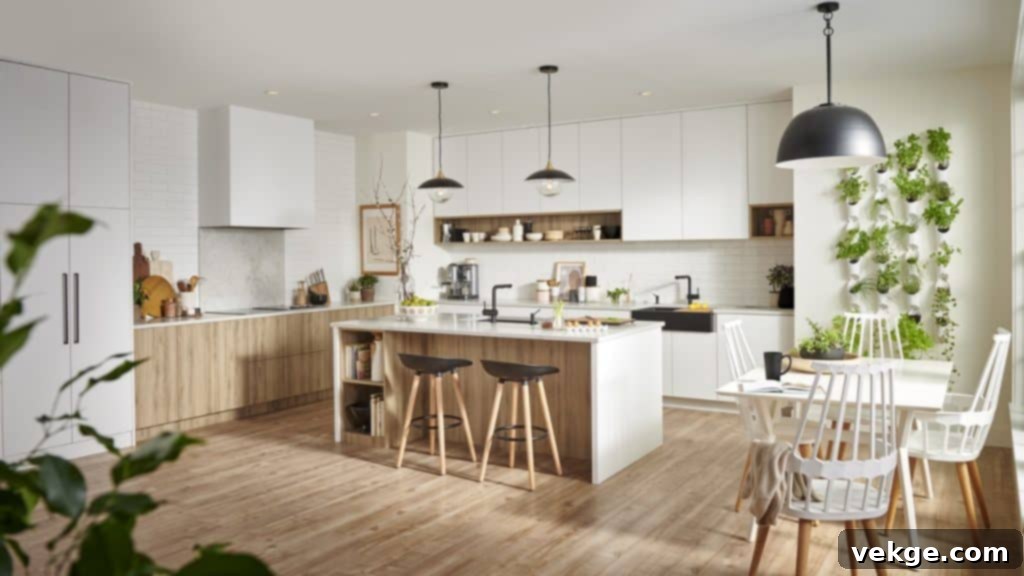
The Scandinavian aesthetic is deeply rooted in simplicity, a characteristic that extends effortlessly into its kitchen designs. Modern Scandinavian kitchens are typically defined by a serene neutral color palette, with crisp white, sophisticated grey, and timeless black serving as the most dominant and popular colors. These foundational hues provide a versatile canvas, allowing for subtle variations and the introduction of natural textures and materials to create a balanced and inviting space.
2. Embrace Clean Lines and Simple Shapes
Scandinavian kitchens are celebrated for their emphasis on clean lines and simple, uncomplicated shapes. This design ethos is so distinctive that it’s often playfully referred to as “the Ikea style,” highlighting its accessibility and widespread appeal. In practice, this means opting for flat-panel cabinetry, often handleless or with minimalist hardware, that creates seamless surfaces. Kitchen islands typically feature strong, angular profiles, contributing to a modern and sophisticated appearance. While the forms are sleek and geometric, the incorporation of natural materials like light-toned wood and subtle stone ensures the space remains grounded, approachable, and far from cold or sterile. To achieve this signature look, begin by decluttering your countertops, ensuring cabinets are neatly organized, and keeping walls free from excessive or unnecessary embellishments. The goal is an uncluttered environment that promotes a sense of calm and order.

The simplicity of form is not just about aesthetics; it’s about creating a highly functional space that is easy to navigate and maintain. Every element serves a purpose, contributing to a streamlined and efficient kitchen environment.
3. Let in Plenty of Light
Scandinavian kitchens are renowned for their inherently bright and airy design, a direct response to the Nordic climate’s limited daylight hours. Therefore, maximizing natural light is not merely a design choice but a fundamental requirement. This can be achieved through various architectural elements such as installing large, unobstructed windows, incorporating skylights to flood the space with overhead light, and utilizing light-colored cabinetry that reflects rather than absorbs light. White or pale wood cabinetry, for instance, dramatically enhances the brightness. Beyond natural light, consider a layered approach to artificial lighting: ambient lighting for overall illumination, task lighting for work areas (like under-cabinet lights), and accent lighting to highlight features. The result is a welcoming, cheerful, and uplifting space that feels significantly more expansive and inviting, regardless of its actual footprint.
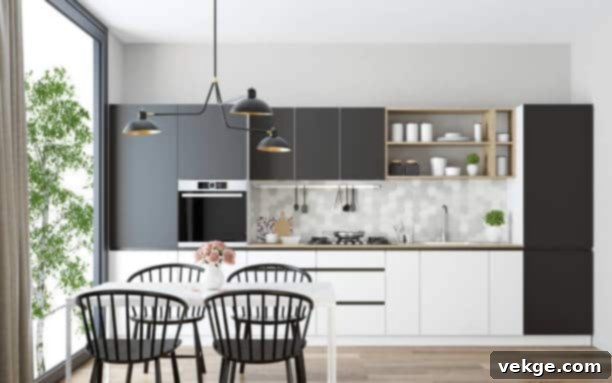
Minimalist window treatments, or even foregoing them entirely, allow maximum light penetration and maintain the uncluttered aesthetic. Strategic placement of mirrors can also amplify light and create an illusion of greater depth in the space.
4. Incorporate Organic Materials
Scandinavian kitchens are designed to be beautiful, functional spaces for all aspects of home life – cooking, dining, and socializing. A key element in achieving this sought-after aesthetic is the thoughtful integration of organic materials, which inherently introduce warmth, authenticity, and a connection to nature. Wood, particularly light-toned species like birch, ash, or pale oak, is paramount and can be utilized extensively in flooring, cabinetry, and even countertops for a seamlessly natural look. Natural stone, such as marble or granite with subtle veining, adds a touch of understated luxury and durability. Beyond these primary materials, consider woven textiles like wool or cotton for rugs and dishcloths, ceramic tableware, and leather accents in seating. These elements collectively transform modern Scandinavian kitchens into warm, inviting, and tactile environments. Further enhancing this natural feel, the addition of living plants or fresh greenery not only introduces vibrant color but also contributes to a sense of calm and well-being.
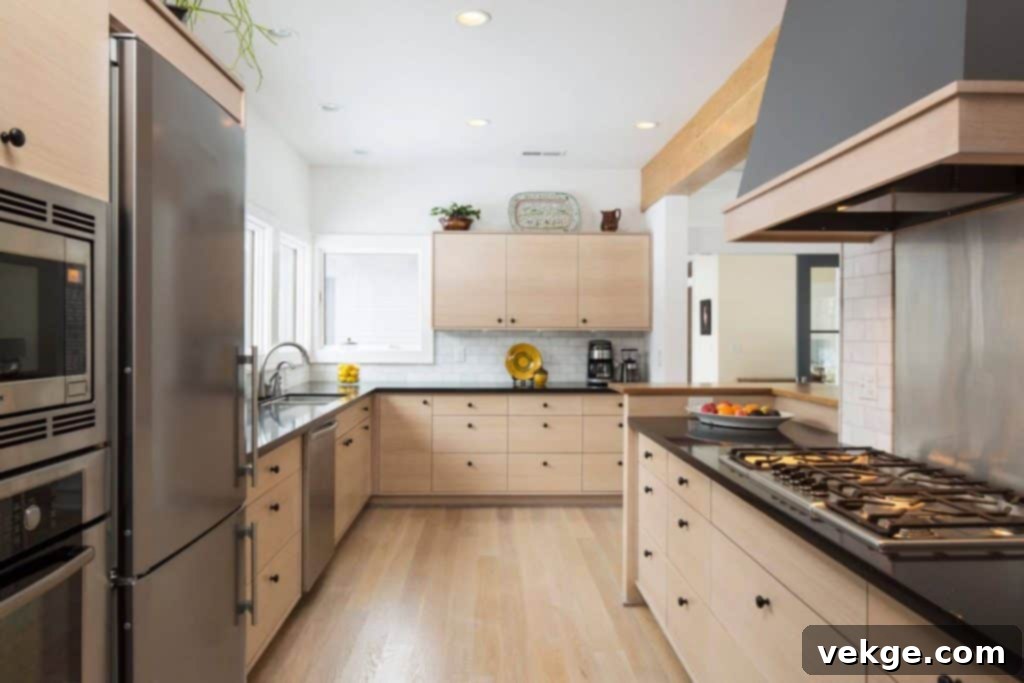
The beauty of organic materials lies in their ability to age gracefully and tell a story, adding character and depth that synthetic alternatives often lack. They contribute to the “hygge” feeling – a sense of cozy contentment and well-being.
5. Choose the Right Appliances
The choice of appliances plays a significant role in defining the look of modern Scandinavian kitchens. Traditionally, the use of white appliances has been a defining characteristic, contributing to the open, airy, and seamless feel of the kitchen. White appliances blend effortlessly with neutral cabinetry and walls, creating an uninterrupted flow and a sense of expanded space. However, this doesn’t mean your design must be entirely devoid of personality! While a predominantly white palette is classic, there’s ample room to introduce pops of color or sophisticated contrast. Consider sleek, integrated appliances that disappear behind custom cabinet panels for an ultra-minimalist look, or opt for contemporary stainless steel models that offer a clean, professional aesthetic. Alternatively, for those who dare to be bolder, a retro-style brightly colored fridge or a statement blue dishwasher can inject unexpected character and visual interest, provided the chosen color harmonizes thoughtfully with the overall kitchen design. The key is balance and intentionality in your choices.

Functionality should always dictate the choice of appliances, but in Scandinavian design, form follows function with elegance. High-quality, energy-efficient appliances that offer a sleek profile are always a good investment.
6. Minimalism
Scandinavian design is almost synonymous with minimalism, a philosophy that, when executed correctly, can create spaces that are profoundly warm and inviting, rather than cold or sterile. In a Scandinavian kitchen, minimalism is employed to cultivate an environment that feels inherently open, calm, and utterly uncluttered. This approach emphasizes quality over quantity, focusing on essential items and cleverly designed storage solutions that keep visual noise to a minimum. To achieve this, prioritize keeping surfaces clear and free of unnecessary items. Select a limited, cohesive color palette, relying on clean lines and simple geometric shapes for your cabinetry, furniture, and decorative elements. The choice of hardware in Scandinavian kitchens often leans towards discreet or integrated options, allowing the inherent beauty of other design elements, such as natural wood grain or textured countertops, to truly stand out, contributing to a sleek, harmonious, and sophisticated overall look.
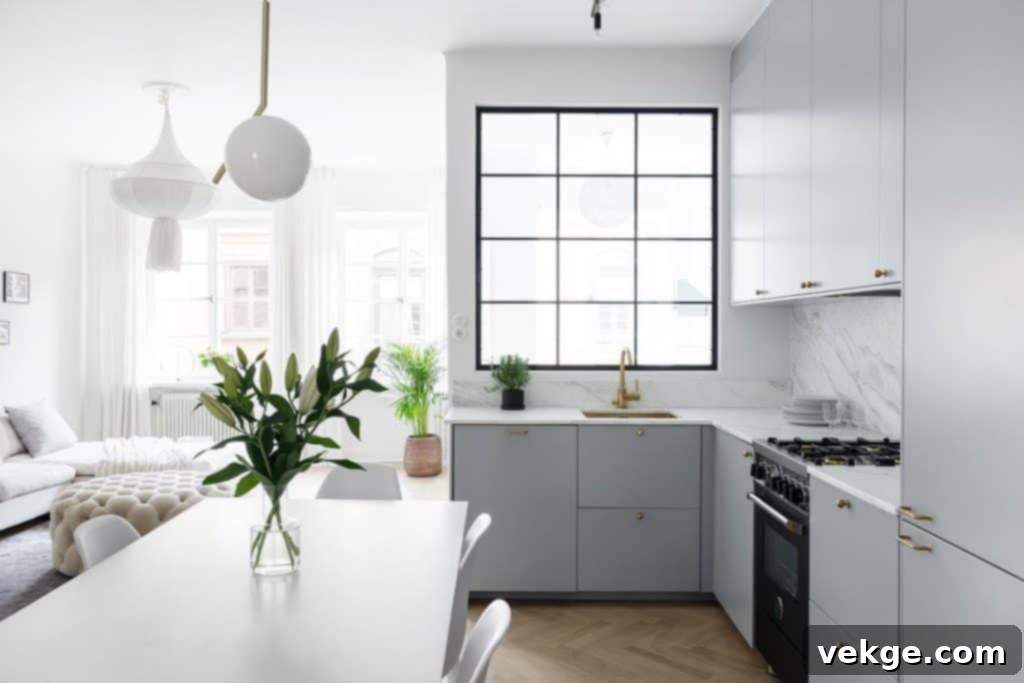
True minimalism in a Scandinavian context isn’t about stark emptiness, but rather about intentionality – every item present serves a purpose or brings joy, contributing to a sense of peace and efficiency in your daily life.
7. Embrace White Space
One of the most instantly recognizable and defining characteristics of Scandinavian kitchen design is the generous and intentional use of white space. This concept extends beyond merely painting walls white; it involves creating expansive, uncluttered areas that function as a clean canvas, allowing other carefully chosen elements to breathe and shine. This blank backdrop makes your kitchen feel larger, brighter, and inherently more adaptable to your personal style. If you’re looking to infuse your kitchen with a Scandinavian makeover, a vital first step is to open up the space as much as possible, starting with fresh white paint on the walls. This creates an immediate sense of spaciousness and serves as the perfect foundation for the rest of your design choices.
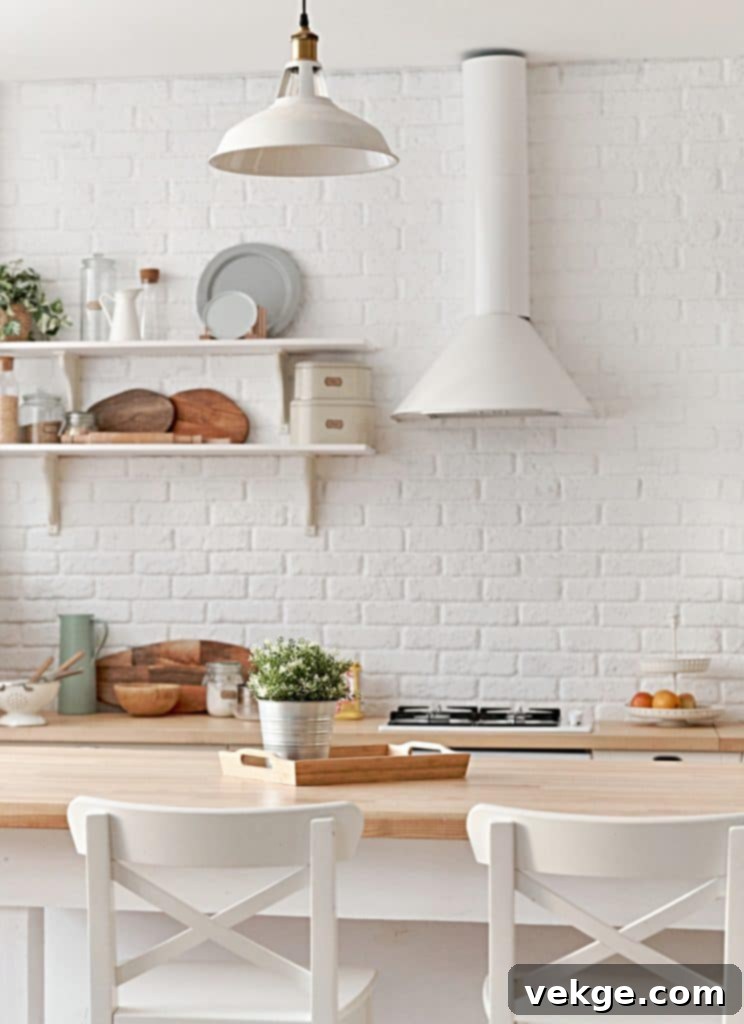
Beyond wall color, here are additional ways to effectively utilize and enhance white space:
- Add floating shelves, especially around glass doors or in open wall areas, to store and tastefully display cherished collectibles or essential items, keeping them organized while adding visual interest.
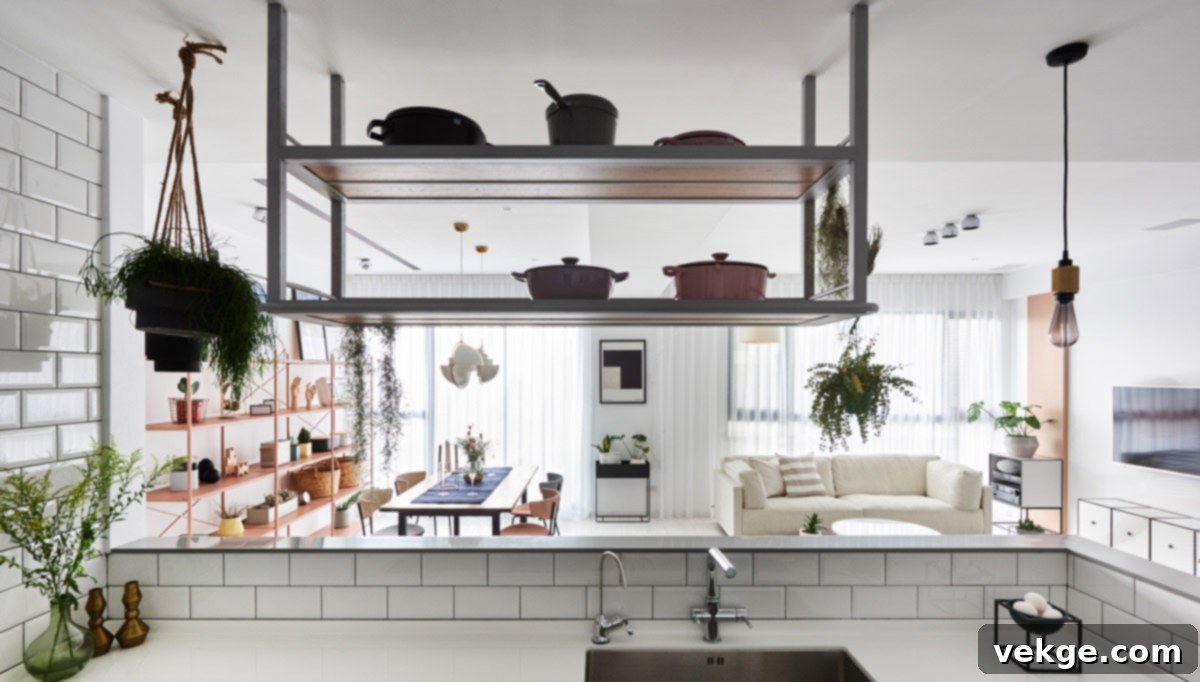
- Employ low-hanging storage containers or thoughtfully designed base cabinets to maximize practical storage space without obstructing wall areas, which in turn allows more natural light to penetrate the room.
- Leverage expansive blank wall space to showcase curated pieces of art or decor items that embody the clean lines and understated elegance characteristic of the Scandinavian style. This turns a functional space into a personal gallery.
8. Incorporate Greenery
Few things instantly evoke the serene and fresh atmosphere of a “Scandinavian kitchen” quite like a generous infusion of greenery. Whether your preference is for a few charming potted plants strategically placed on a sun-drenched windowsill, or you envision a lush, full-fledged indoor herb garden thriving on a wall-mounted system, integrating some greenery into your kitchen is an excellent way to capture that coveted Nordic vibe. Consider resilient and stylish plants like snake plants, ZZ plants, or small fiddle leaf figs for decorative impact, or practical herbs like basil, mint, and rosemary for culinary use.
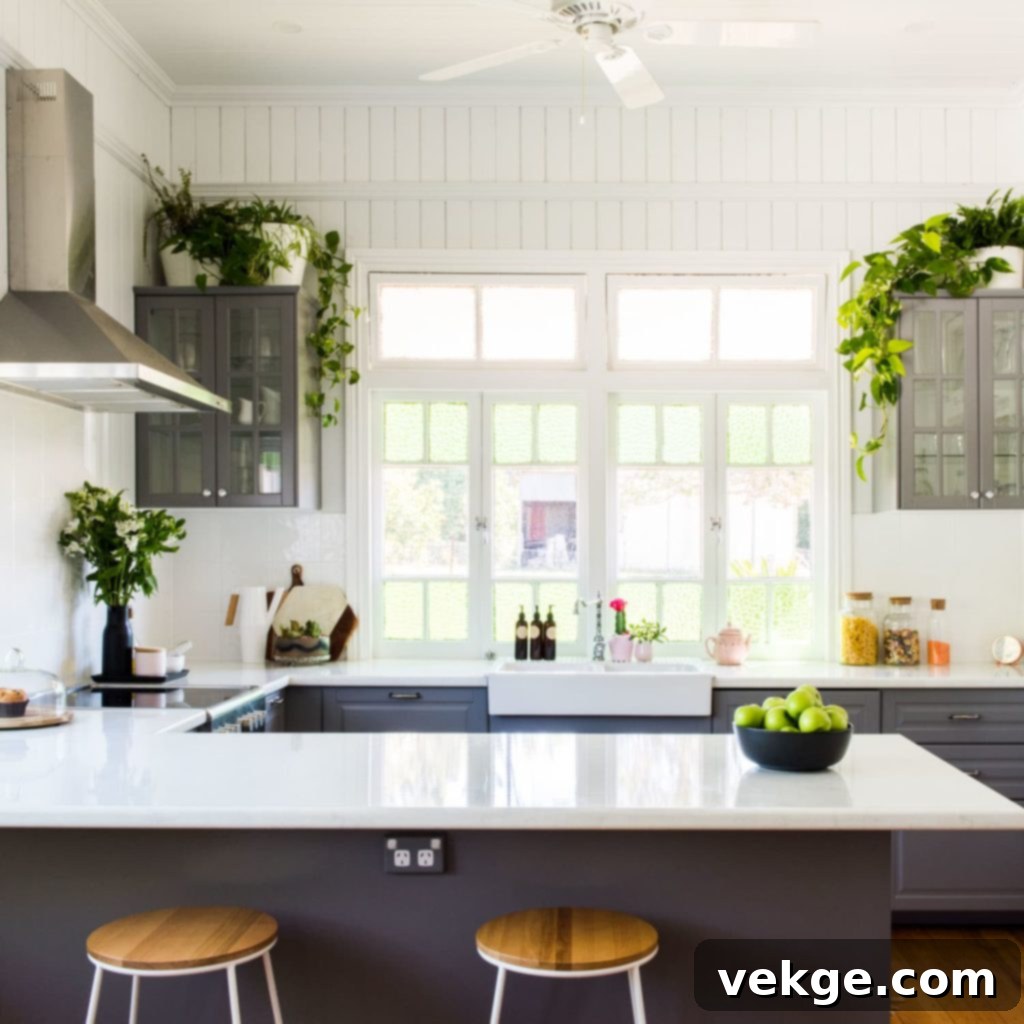
Incorporating these natural elements into your kitchen design is more than just an aesthetic enhancement. Plants not only introduce vibrant splashes of color and organic forms to an otherwise minimalist space but also contribute to a profound sense of warmth, serenity, and a naturally fresh, uplifting atmosphere. They purify the air and connect the indoor environment with the outdoors, a core principle of Scandinavian living.
9. Use Interesting Textures
In modern Scandinavian kitchen design, where neutral color palettes and clean lines prevail, the strategic incorporation of varied textures becomes a key element to prevent the space from feeling flat or uninviting. Texture adds crucial depth, visual interest, and a tactile quality that enriches the overall aesthetic. This can be achieved in numerous subtle yet impactful ways: consider utilizing different materials for your worktops, such as a matte-finish quartz or a light-colored granite, juxtaposed with smooth, flat-panel cabinetry. A textured splashback, perhaps made from small, subtly patterned tiles or even exposed brick painted white, can create an engaging focal point. Beyond these major surfaces, you can further integrate interesting textures through woven rugs, linen dish towels, ceramic pottery, brushed metal hardware, or even a statement lighting fixture with a unique material like rattan or unglazed ceramic. By carefully layering various textures, you can create a kitchen that is visually captivating, rich with subtle detail, and inherently more inviting and appealing.
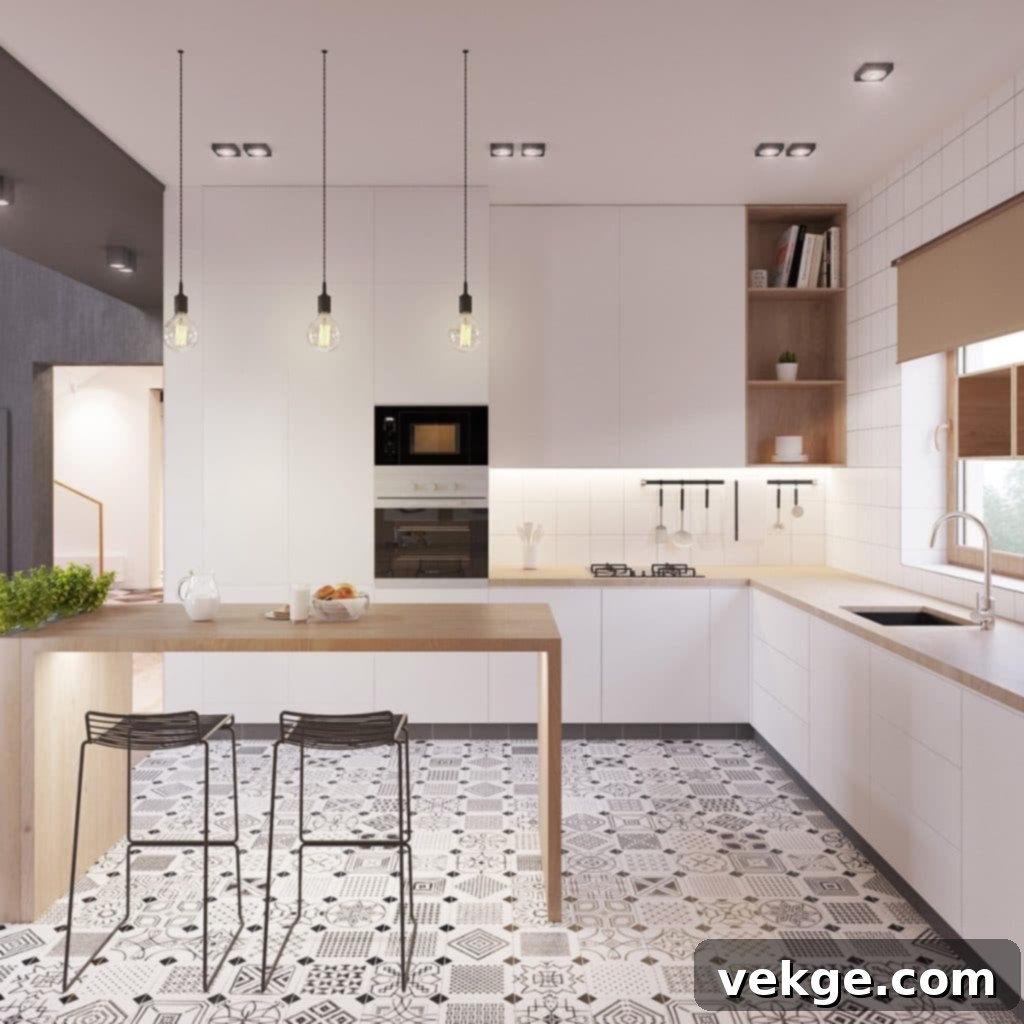
From the smooth coolness of a stone countertop to the warmth of a wooden floor, and the subtle weave of a fabric blind, each texture contributes to a rich sensory experience within the minimalist framework.
10. Go for a Monochrome Look
A consistently popular and enduring trend in modern Scandinavian kitchens is the sophisticated monochrome color scheme. This aesthetic is elegantly achieved by utilizing varying shades of white, black, and grey throughout the kitchen space. Far from being boring, this type of color scheme offers both timeless style and incredible versatility. The subtle shifts in tone and saturation between whites, off-whites, greys, and blacks create visual depth and sophistication without the need for additional colors. This cohesive palette is remarkably adaptable, allowing for easy updates or seasonal changes simply by swapping out small decorative elements. While Scandinavian design is often perceived as clean and minimal, there’s no rigid rule that forbids color. A thoughtfully executed monochromatic scheme, perhaps featuring a striking black island against white cabinetry or different shades of grey on walls and floors, is an excellent way to introduce compelling visual interest and a sense of refined elegance to any Scandinavian kitchen, proving that subtle color variations can be just as impactful as bold hues.
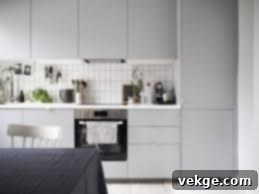
The beauty of a monochrome palette is its ability to create a calming, cohesive backdrop that highlights the architecture and natural light, rather than competing with it. It’s a testament to the power of understated elegance.
11. Use Plenty of Wood
Wood is undeniably a cornerstone material in Scandinavian design, and its abundant use in kitchens is central to creating that signature warm, inviting, and naturally grounded aesthetic. Many authentic Scandinavian kitchens are built with a strong emphasis on wood elements, often showcasing its natural beauty. You can create a visually stunning and balanced monochrome look by contrasting painted elements with natural wood: consider painting your cabinets, counters, and island in crisp white or a pale grey, then introduce natural wood for your floors, a contrasting backsplash, and accent pieces like open shelves, bar stools, or dining furniture. Light wood floors, such as those made from pale oak, birch, or pine, are a classic and highly practical choice for Scandinavian kitchens. They instantly infuse warmth and an organic touch into the space, are durable, and relatively easy to maintain, developing a beautiful patina over time. Beyond floors and cabinetry, wood can also feature in ceiling beams, wall panels, and even utensils or decorative bowls, reinforcing the connection to nature and enhancing the cozy “hygge” atmosphere.
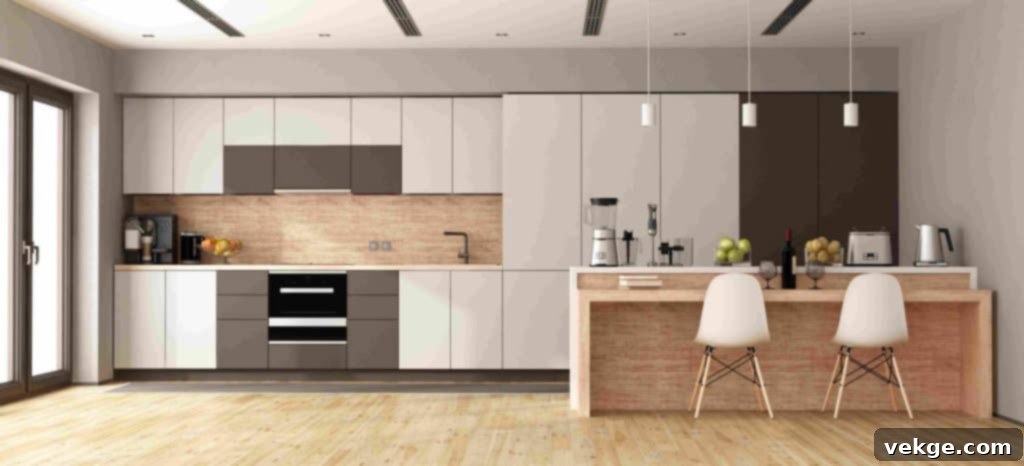
The enduring appeal of wood in Scandinavian design lies in its timeless beauty, durability, and its ability to seamlessly integrate with other natural and minimalist elements, creating a truly harmonious space.
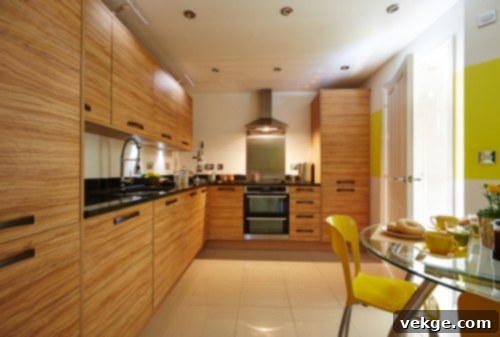
12. Incorporate a Pop of Color
While a neutral or monochrome color scheme forms the classic foundation of Scandinavian design, strategically introducing a “pop of color” is an effective way to inject personality, dynamism, and modern flair into your kitchen. This doesn’t mean abandoning the minimalist aesthetic; rather, it’s about thoughtful and restrained application of brighter hues. A single, vibrant accent piece, such as a striking red pendant light, a colorful toaster, or a curated piece of contemporary artwork, can add just the right amount of visual interest and individuality without overwhelming the serene backdrop. If you’re unsure where to begin, start small: consider a brightly colored geometric rug under the dining table, a set of colorful kitchen towels, or a few carefully selected small appliances in an unexpected shade. More boldly, you could designate one wall for a subtle accent color or introduce patterns through tiles or wallpapers on a single feature wall. The key is to maintain balance and ensure the chosen color enhances, rather than detracts from, the overall harmony and clean aesthetic of the Scandinavian space.
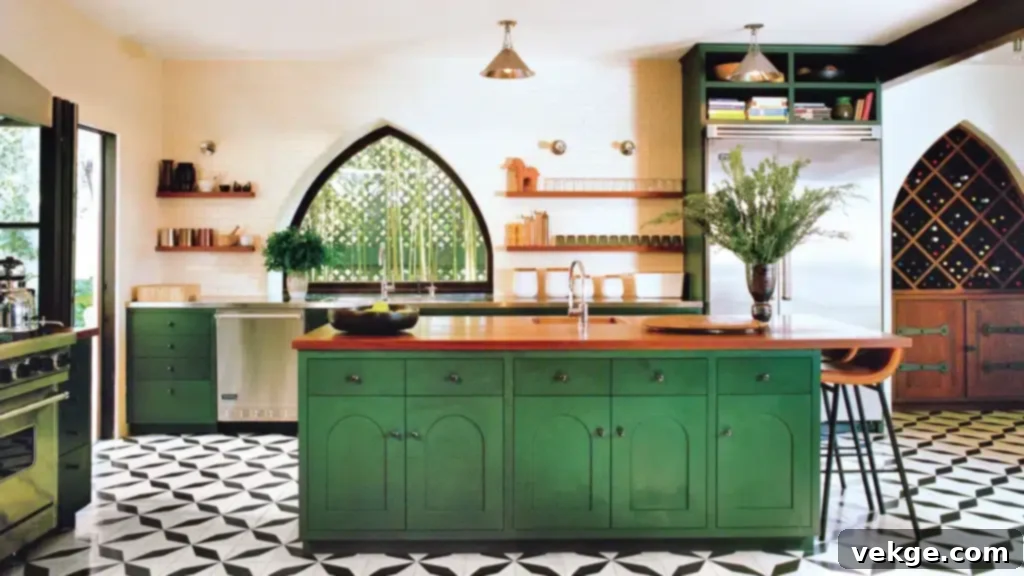
A pop of color, when used judiciously, can serve as an unexpected focal point, drawing the eye and adding a layer of sophisticated playfulness to the minimalist environment.
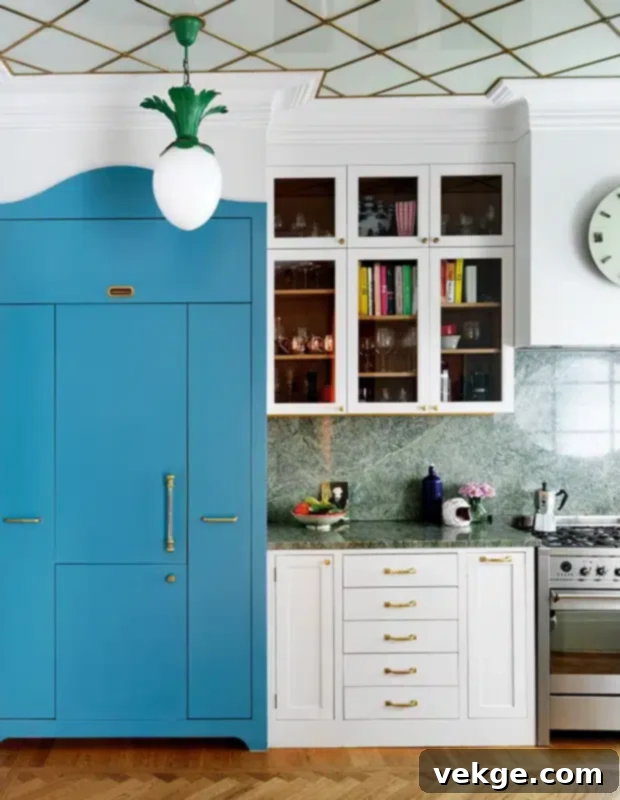
13. Use Unique Storage Solutions
Sleek, modern, and highly functional, Scandinavian kitchens excel at innovative storage solutions that keep clutter at bay and maintain the clean lines central to the design. A multitude of creative options exist to efficiently store items without compromising the aesthetic. Floating shelves are a popular choice, perfect for organizing and displaying frequently used spices, aesthetically pleasing dishes, or small decorative accents. Magnetic strips installed on walls offer a smart way to hang knives, pots, and pans, freeing up drawer and cabinet space while keeping essentials within easy reach. Beyond these, consider integrated drawer organizers for cutlery and utensils, pull-out pantry systems for efficient food storage, or even custom-built cabinetry that perfectly fits awkward spaces. Don’t be afraid to get creative with your storage, but remember that functionality is paramount! While the primary goal is practicality, these solutions don’t have to be visually dull. Wall-mounted shelves, for instance, are a fantastic way to add extra storage without consuming precious floor or counter space, and they can double as platforms to artfully display your favorite kitchen items, adding character and warmth to the minimalist setting.
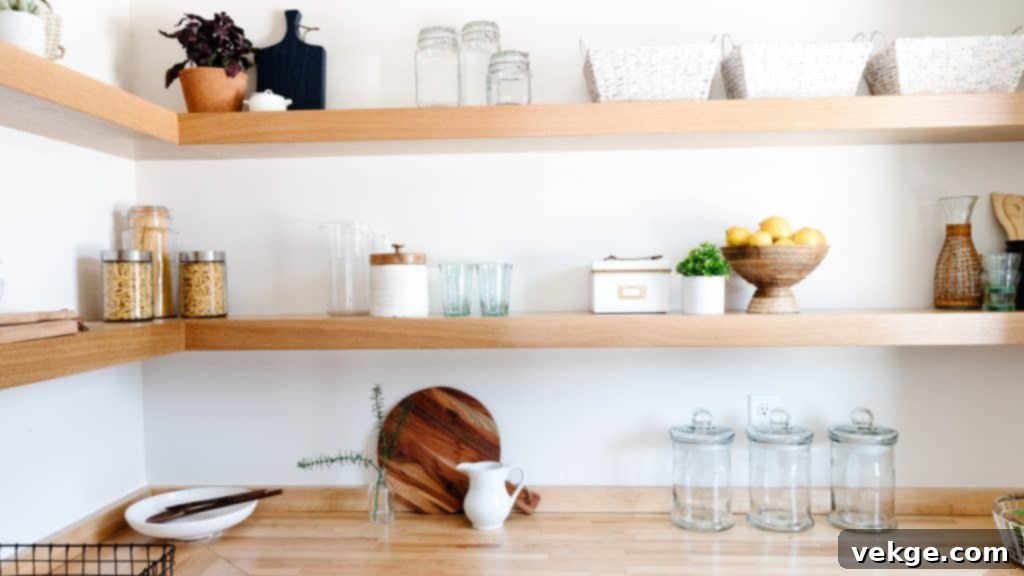
Smart storage contributes significantly to the calm and efficiency of a Scandinavian kitchen, turning potential clutter into an organized and visually pleasing feature.
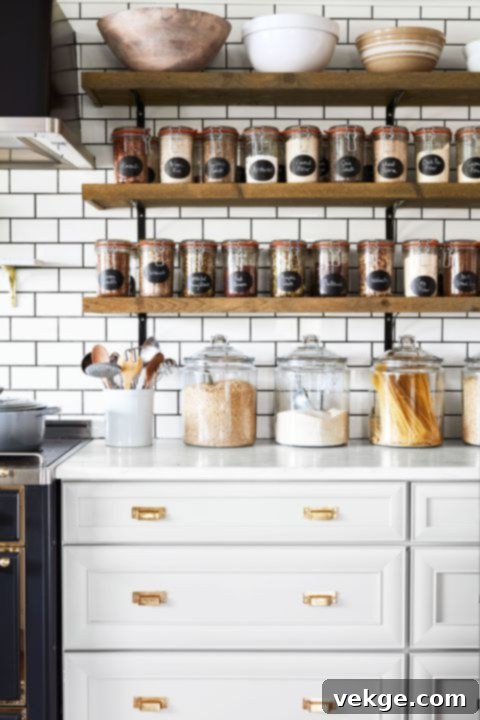
14. Consider Scale for Fixtures and Fittings
When embarking on incorporating Scandinavian kitchen design ideas into your own cooking space, one of the foremost considerations must be the concept of scale. The visual impact and functionality of your kitchen are heavily influenced by how well your fixtures and fittings are proportioned to the overall size of the room. For example, in a smaller, more intimate kitchen, opting for compact, streamlined appliances, smaller light fixtures, and minimalist cabinet hardware will help the space feel more open and prevent it from appearing overwhelmed. Conversely, a larger, open-plan kitchen can comfortably accommodate more substantial pieces, such as a grander island, larger statement pendant lights, or wider sink basins, all without sacrificing the characteristic clean aesthetic. It’s crucial to remember that what looks harmonious and effective in an expansive, open-plan setting may not translate as successfully to a more compact area. Careful attention to scale ensures that every element feels deliberate and contributes to a balanced, aesthetically pleasing, and highly functional kitchen environment, maintaining the essence of Scandinavian design.
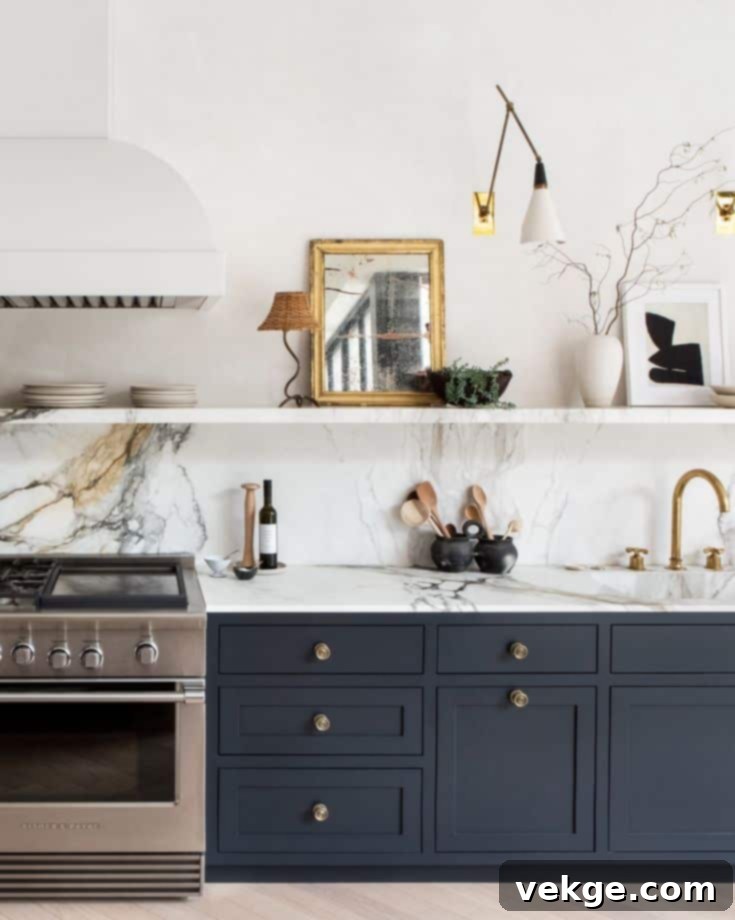
Proper scaling ensures visual harmony, making the space feel thoughtfully designed and comfortable, rather than cluttered or disproportionate.
15. Granite Countertops
In the realm of modern Scandinavian kitchens, granite countertops stand out as one of the most consistently popular and highly favored choices. The inherent qualities of granite — its clean, often subtle lines, its beautiful and natural color variations, and its exceptional durability — make it perfectly aligned with the core tenets of this design style. Granite offers a resilient and long-lasting surface that can withstand the demands of a busy kitchen, while its unique patterns and natural veining add a touch of organic beauty without overwhelming the minimalist aesthetic. Beyond granite, other excellent choices for Scandinavian kitchens include quartz (for its consistent appearance and low maintenance), butcher block (for unparalleled warmth and tactile appeal), or even concrete (for an edgy, industrial-minimalist twist). Regardless of the specific material, a high-quality countertop adds a touch of understated luxury and sophisticated functionality to any kitchen. Its robust nature and ease of cleaning make it an ideal choice for busy families who prioritize both style and practicality in their everyday living spaces.
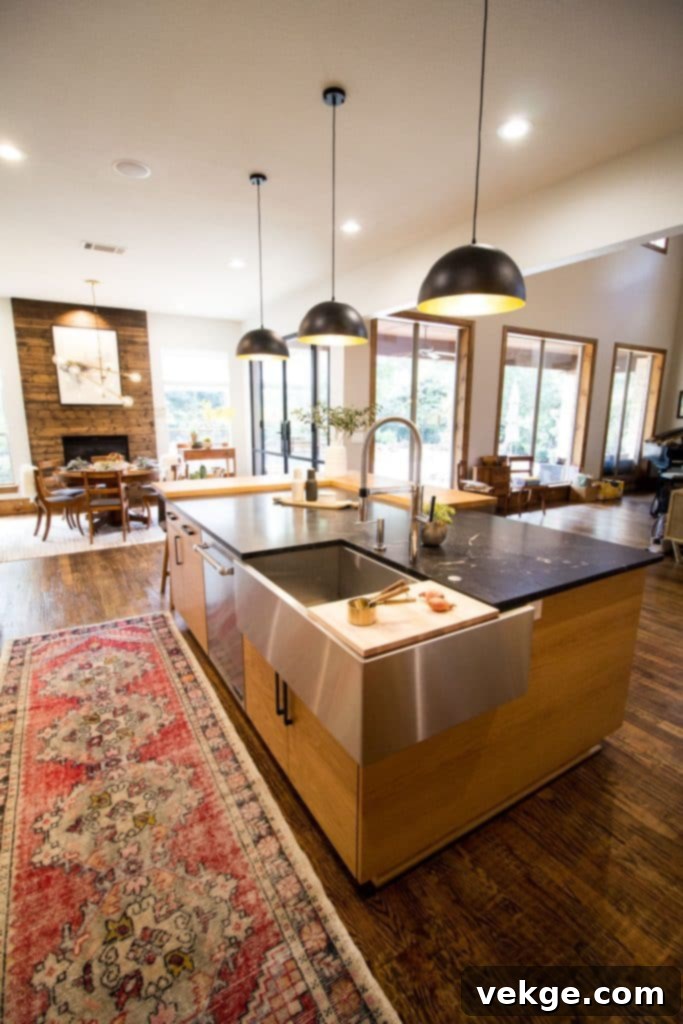
Choosing the right countertop material is a long-term decision that significantly impacts both the aesthetics and practicality of your Scandinavian kitchen, ensuring it remains beautiful and functional for years to come.
The Bottom Line
If you’re contemplating a renovation or simply looking to refresh an outdated kitchen, focusing on a minimalist, modern Scandinavian design aesthetic presents a truly fantastic and rewarding option. This design philosophy, while capable of creating sleek and ultra-modern spaces, truly shines when it delivers environments that are bright, airy, open, and incredibly inviting – perfectly suited for all your culinary adventures and social gatherings. It’s a style that masterfully blends form and function, proving that simplicity can be both sophisticated and deeply comfortable.
As you plan your next kitchen makeover, keep the fundamental elements of modern Scandinavian kitchen design firmly in mind: the extensive use of natural light and embracing white space to maximize openness; incorporating natural greenery for life and serenity; introducing interesting textures to add depth and warmth; opting for serene neutral or monochrome color schemes, thoughtfully punctuated with strategic pops of color; and generously utilizing wood to ground the space in natural elegance.
By integrating these timeless principles and inspiring ideas, you’ll undoubtedly create a stunningly stylish and highly functional new cooking space that will not only take your breath away but also serve as the true heart of your home for years to come.
